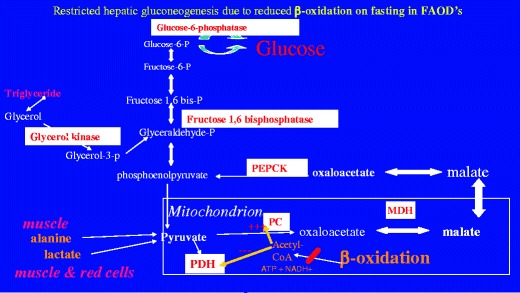Fig. 1.

Interaction of β-oxidation and gluconeogenesis. β-oxidation generates ATP, NADH+ and acetyl-CoA and these stimulate pyruvate carboxylase PC and inhibit pyruvate dehydrogenase PDH. Mobilisation of alanine from muscle, and lactate produced, for example from anaerobic glycolysis in the red cell, are the major sources of pyruvate during catabolic stress. The conversion of pyruvate to oxaloacetate is a crucial step in the process of gluconeogenesis which is mediated through pyruvate carboxylase PC. Acetyl-CoA is the primary activator of this enzyme, which converts pyruvate to oxaloacetate. The equilibrium of the mitochondrial malate dehydrogenase MDH is displaced to favour the reduction of oxaloacetate to malate. ATP is used as a co-substrate for PC and phosphoenoylpuruvate carboxykinase PEPCK. Consequently in defects of fat oxidation this crucial early step of gluconeogenesis is compromised and this also contributes significantly to hypoglycaemia
